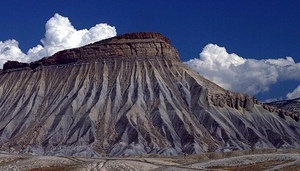Vail-area Rep. Polis, some energy experts doubtful oil shale will ever pan out
Obama administration touches off debate by vowing to revisit Bush leasing rules
Polis was reacting to last week's announcement by U.S. Interior Secretary Ken Salazar, a former Colorado senator, that the U.S. Bureau of Land Management (BLM) is taking a “fresh look” at oil shale leasing rules passed in the waning days of the Bush administration in 2008.

“The brightest hope for America's energy independence has been shut down by an Interior Department that says it wants to review the rules for leases,” Investor's Business Daily wrote in an editorial last week. “It really wants to kill off oil altogether.”
But Vail Valley resident Bill Sepmeier, an adjunct faculty member at Colorado Mountain College teaching solar technology, breaks down the water and energy demands of oil shale production in his “Letters from Mr. Sunshine” blog and concludes:
“No matter what the price, an energy source that requires as much energy to obtain as it delivers is not a source, it's a waste of time,” Sepmeier wrote. “Oh, and did we mention the water issues? Which exceed the flows of the supplies -- the rivers -- in Colorado's oil shale country?”
Still. with crude oil prices creeping back toward $100 a barrel and unrest racking the Middle East from Egypt – where 3 million barrels of mostly U.S.-bound oil passes through the Suez Canal each day – to Bahrain, home to the U.S. Navy's 5th Fleet, it's not surprising there's renewed interest in Colorado's vast oil shale reserves.
“As we all know, the energy challenges our country faces are serious and have gone unaddressed for far too long,” U.S. Bureau of Land Management director Bob Abbey said last week, “and therefore we believe we need to responsibly develop our oil and gas supplies to help us reduce our dependence on foreign oil, but we also must do so in a thoughtful and balanced way.”
Abbey was speaking the same day the BLM filed its settlement in federal district court in Colorado promising to revisit the oil shale leasing rules passed by the Bush. Those rules opened up 2 million acres of BLM land to commercial oil shale leasing and set a royalty rate of 5 percent.
“The previous 2008 regulations made critical decisions such as royalty rate before the RD&D [research, development and demonstration] program had a chance to deliver information and answers,” Salazar said. “They put the cart before the horse, and in so doing they heightened the risk of speculation and bad decisions and yet another oil shale bust.”
Salazar was referring to “Black Sunday” on May 2, 1982, when Exxon pulled the plug on its Colony oil shale project and laid off 2,200 workers on Colorado's Western Slope. Whole towns from Parachute to Rifle virtually went bust overnight. Exxon was one of three companies selected last year by the Obama administration for a second round of RD&D leases.
It's estimated the United States holds more than half the world's oil shale reserves, with more than 2 trillion barrels of oil equivalent trapped in the shale rock between 1,000 and 2,000 feet below the surface of a 16,000-square-mile area of Colorado, Utah and Wyoming called the Green River Formation. Between 70 and 80 percent of that oil shale is beneath federal land.
Such reserves, if ever commercially tapped, would far outstrip Saudi Arabia's known reserves of 260 billion barrels and even its projected reserves, including expected new discoveries, of 900 billion barrels. However, the projected reserves may have been overstated by as much as 40 percent, according to dispatches from a top Saudi oil exploration engineer leaked by Wikileaks.
Companies for more than a century have been trying to figure out how to commercially unlock the oil from the rocks in the American West. It's a costly process that involves heating up the rocks to more than 700 degree Fahrenheit and extracting the organic kerogen. The current process consumes inordinate amounts of conventional power and already scarce western water supplies.
Shell, which has been working for years on its In situ Conversion Process at the Mahogany Research Project in Rio Blanco County, has acknowledged it currently takes at least three barrels of water for every barrel of oil produced from oil shale.
“In the last six years U.S. natural gas production has increased 20 percent,” said Randy Udall of the Association for the Study of Peak Oil & Gas – USA. “In North Dakota, the Bakken Formation is yielding 300,000 more barrels of oil today than it did five years ago. The oil and gas industry is very good at unlocking difficult oil and gas petroleum resources.
“But oil shale continues to be a laggard. It continues to be a no-show, and one must really wonder whether oil shale is ever likely to be a significant player in U.S. energy supplies.”
Udall points out that global oil shale production has never exceeded more than 25,000 barrels a day, largely because the process have never been proven commercially viable. Still, with conventional oil supplies locked up in politically volatile regions of the world and crude prices climbing, companies like Exxon and Shell continue to explore oil shale's vast potential.
Even Udall, an environmentalist and advocate for more sustainable energy policies, acknowledges that “the potential resource is so large – a trillion tons of these rocks – that I think it's really unreasonable to expect the nation to entirely turn its back on them.”
A Rand Corporation report on oil shale estimates it could take up to 1,200 megawatts of power to produce 100,000 barrels of oil shale oil per day. To produce 1 million barrels of oil a day – or 5 percent of current U.S. consumption -- it could take the equivalent of up to 10 new coal-fired power plants in Colorado. That has prompted oil and gas companies to explore other sources of energy to fuel production, and some politicians have even speculated that nuclear power may be the answer.
But water remains the biggest hurdle.
“From our perspective, oil is perhaps a scarce resource, but water is also pretty scarce here in the arid West, and fish and wildlife habitat and the hunting and fishing and outdoor recreation that habitat provides is a resource that has helped sustain rural communities in the West,” said Kate Zimmerman of the Rocky Mountain Regional Center of the National Wildlife Federation.
Bill Midcap of the Rocky Mountain Farmers Union (RMFU) worries oil shale production could adversely impact his industry as well.
“Every drop of water Mother Nature blesses Colorado with has the potential to run out of our state,” Midcap said. “How society chooses to use that water is a really good question. The dependence on agriculture in this state is huge; we are the second largest industry in the state. We can't just keep doing more with less.”
![]() 3 Comments on "Vail-area Rep. Polis, some energy experts doubtful oil shale will ever pan out"
3 Comments on "Vail-area Rep. Polis, some energy experts doubtful oil shale will ever pan out"
Jeremy Boak – Feb. 27, 2011, at 1:38 p.m.
It is curious to quote a teacher of solar energy as evidence that "some experts" are doubtful that oil shale will ever be a viable energy resource. The person quoted implies that oil shale has a negative energy return on investment, but provides no evidence that that is the case. Most estimates, including that of Stanford researcher Adam Brandt indicate significant positive energy returns, up to 11 to 1.
Although water use will be an important questions for oil shale, companies have the water rights they need to produce fairly large quantities of shale oil. The 1-3 barrels per barrel is a great deal smaller than the water use estimates for most forms of biofuel, and the threat to West Slope water is at least as great from Front Range communities as it is from oil and gas production.
Randy Udall's perpetual opposition to oil shale production is well known, but he brings no technical competence to his evaluation. Oil shale production is increasing again worldwide, and current plans would likely increase it by about fivefold over the next five years. It will take a long time to reach large industrial scale production, but large companies continue to invest in research and development. Oil shale is commercially viable in the three countries that now produce it.
No company currently investigating oil shale production plans to use coal-fired generating capacity for large scale production of oil shale. It is odd that the 2004 (I think) Rand Corporation report continues to be cited as the authority on oil shale production when five years of Oil Shale Symposia here in Colorado, and regularly updated Web-available DOE documents provide a much more up-to-date picture of the industry. It is sad to see such an imbalanced article presented as news.
Jeremy Boak, Director
Center for Oil Shale Technology and Research
Colorado School of Mines
RHernandez – March 02, 2011, at 1:40 p.m.
David O. Williams is well-known for slanting all of his "news" stories against energy and resource development. So, take it all with a grain of salt.
I applaud Dr. Boak's comments above. With oil topping $100/barrel today, we need to be exploring our domestic resources. And, oil shale is a biggie (over 1 trillion barrels).
Spectacular progress has been made on oil shale technology development in recent years. While water will be used, it is not going to dry up Western Colorado by any means.
For instance, the Yampa/White Basin Roundtable of the Colorado Water Conservation Board estimates a 550,000 barrel/day industry would use about 45,000 acre-feet per year. Now, this is not a small quantity. However, this is using current technologies - that will surely improve over time. And, if we keep more of our water on the West Slope and don't export it elsewhere - and perhaps build more water storage - there is likely plenty of water in Colorado, Utah, and Wyoming for a moderately-sized industry. And, some companies say their process will use almost no water.
We need to base our policy on facts, not propaganda from people like Mr. Williams, Rep. Polis, and others.


 Vail Town Council to weigh new plan to redevelop T...
Vail Town Council to weigh new plan to redevelop T...  All about indexes
All about indexes  Transforming your social security into a winning r...
Transforming your social security into a winning r...  Pass sales, real estate transactions, revenues inc...
Pass sales, real estate transactions, revenues inc...  Vail Valley native with passion for Biophilic inte...
Vail Valley native with passion for Biophilic inte...  Beaver Creek starts work on new summer activities
Beaver Creek starts work on new summer activities  Land Trust, ECO Trails, Vail Resorts team up to cl...
Land Trust, ECO Trails, Vail Resorts team up to cl...  EUROVISION named Host Broadcaster for 2015 World A...
EUROVISION named Host Broadcaster for 2015 World A...  Vail Resorts brings back Lindsey Vonn's 'School of...
Vail Resorts brings back Lindsey Vonn's 'School of...  Hundreds turn out for 2015 World Championships vol...
Hundreds turn out for 2015 World Championships vol...  Eagle County Senior Health Expo and 9th Annual Hea...
Eagle County Senior Health Expo and 9th Annual Hea...  Final race of Vail Mountain Trail Running Series s...
Final race of Vail Mountain Trail Running Series s...  Before you write your will ...
Before you write your will ...  2015 World Ski Championships volunteer recruitment...
2015 World Ski Championships volunteer recruitment...  Ascent Sotheby’s International Realty in Vail an...
Ascent Sotheby’s International Realty in Vail an...  CDOT outlines road closures for local stages of US...
CDOT outlines road closures for local stages of US...  Italian artist creates unique trophies for Vail, B...
Italian artist creates unique trophies for Vail, B...  Vail Recreation District once again hosting Jake W...
Vail Recreation District once again hosting Jake W... 


imannoyed – Feb. 21, 2011, at 7:52 p.m.
South Africa has been converting coal to liquid fuel since 1958. It is beyond me why we are 50+ years behind them.
One arguement placed above by a Solar Energy professor is that we simply cannot use more energy in the manufacture of energy than the amount of energy produced; this is a negative production. However, we do this very thing with corn ethanol (http://oilblog.wordpress.com/2008/06/28/corn-ethanol-good-news-or-boondogle/); we spend nearly 1.5 gallons of petroleum based fuels to create one gallon of corn ethanol.
As for the argument that water is scarce, I agree. But again, this same group of people will promote corn ethanol in exchange for diminishing farmland for the production of wheat and other consumables with no problem.
Oil shale must continue to be a considered source of energy and companies like Shell need to be supported in their efforts to find the best methods of production.